Patriarchy Inc.: What We Get Incorrect About Gender Equality and Why Males Nonetheless Win at Work Cordelia Positive Atlantic (2025)
In 2021, white males managed round 95% of US hedge-fund property. In 2024, solely one of many 40 largest banks on this planet had a feminine chief government. And in a mean UK week, males spend extra of their time in paid work or schooling than doing unpaid duties comparable to family chores or caring for kids; for ladies, it’s the reverse.
How did we get right here? We all know the reply, as psychologist Cordelia Positive tells us in her partaking guide Patriarchy Inc. Sure, the offender is patriarchy: gender influences who will get energy, standing, cash and entry to alternatives. However the place this patriarchal framework stems from and how one can construct a extra equitable society are more durable to pin down.
Intercourse and gender in science
Positive units out to dismantle two present “false visions” for gender equality. The primary of those is the view that women and men are ‘totally different however equal’, a stance that emerged within the Nineteen Nineties. The second is the idea of variety, fairness and inclusion (DEI) — a framework of insurance policies and initiatives to extend office illustration of individuals from marginalized teams — which has unfold like wildfire within the enterprise world and past for the reason that 2010s. Positive focuses on critiquing ‘enterprise DEI’ — however, in so doing, misses the possibility to discover simpler methods to enhance gender fairness.
The assorted methods that enterprise DEI has sprouted to enhance gender variety within the office, comparable to variety workshops and numbers video games of equal-representational hiring, are aimed extra at boosting productiveness than at serving to ladies. The strategy can also be typically tokenistic, and fails to immediate a lot change: stereotypes and gendered norms proceed to affect who will get forward.
Views about how gender bias arose are inclined to fall into two camps, explains Positive. Many anthropologists and psychologists level to biology and evolution to justify the widespread gendered division of labour: males are typically stronger, they are saying, and ladies extra caring. Others insist that cultural conditioning is on the root of gendered roles. On this world view, kids decide up norms about what being a lady or a boy is meant to imply by messaging from their dad and mom, carers, friends and pals, from the media and books round them. They study from an early age who sometimes sews garments or writes pc code.
Positive proposes a compromise: each evolution and social conditioning, she suggests, led to the division of duties by gender. She argues that this has helped societies to reach sure conditions: everyone seems to be extra environment friendly when roles are clearly outlined. However in my discipline — behavioural science — intensive analysis has proven the way it has additionally created standing hierarchies, during which males proceed to imagine ‘necessary’ main roles (typically well-paid) whereas ladies are pushed into supportive, invisible ones (typically remunerated poorly or in no way).
Dispelling intrinsic variations
Though Positive doesn’t focus on it, many feminist actions have lengthy challenged gender norms and the gender binary extra typically. And plenty of students, together with me, have been critiquing the insular and superficial approaches of DEI for some time. However clearly, ladies proceed to hold a lot of the invisible psychological load within the office and at residence.
But, on the identical time, different pockets of society are strengthening gender norms. There’s extra strain on ladies than on males to have kids. As soon as they do, ladies are anticipated to hold nearly all of the caring obligations. Strikes to remove ladies’s bodily autonomy and decisions, together with common media panic about falling birthrates, contribute to this divide. And poisonous concepts of masculinity — that males have to be suppliers, in addition to leaders at work and at residence, for instance — are gaining traction, perpetuated notably by Web influencers.

‘Totally different however equal’ approaches to gender equality lose sight of within-group variations.Credit score: Eduardo Gonzlez/500px/Getty
In any case, it’s a mistake to attribute inherently totally different skills to men and women merely due to the intercourse they had been assigned at beginning — not least as a result of it ignores within-group variations. Not all ladies are the identical. And past particular person variations, we all know how gender norms are racially grounded and the way historic legacies of oppression have performed out. Black and Brown ladies typically report being held to totally different expectations from their white colleagues, as I describe in my 2022 guide Hysterical. Efforts to ‘outline’ gender by organic parameters — comparable to testosterone ranges, used as a main indicator of eligibility for ladies’s sports activities — sometimes take white European ladies as a baseline, regardless that typical ranges can range with race and ethnicity.
Extra broadly, the concept there may be some form of ‘female’ mind-set and dealing has hindered efforts to sort out gender inequalities. It pigeonholes ladies, placing them into new packing containers moderately than disrupting those during which they’ve lengthy been held captive.
Lacking the mark on DEI
Positive touches on the concept gender equality will enhance the lives of everybody — not simply these of ladies. This will at first appear counter-intuitive, as a result of males are at a transparent benefit within the present patriarchal framework; on the face of it, it might sound as if giving equal rights to ladies means limiting males’s rights. I want Positive had laid out extra clearly how gendered norms can even hurt males by stifling them into a selected position. Emotional vulnerability, for instance, is deemed unsuitable for males, a place that can result in mental-health points.
Black ladies on the educational tightrope: 4 students weigh in
And so gender equality ought to be the aim in itself. However organizations don’t work to interrupt gender obstacles only for the larger good — they wish to see worth and revenue. It’s to get them on board that some have endeavoured to ‘promote’ equality work by highlighting that numerous groups carry out higher. Though initially well-intentioned, this strategy has moved away from the unique objectives of DEI and created new types of gendered labour. It’s largely ladies, and folks from different marginalized teams, who carry the load of DEI initiatives, for instance by casual mentorships.

